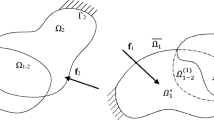Abstract
The purpose of this paper was to study the layout design of the components and their supporting structures in a finite packing space. A coupled shape and topology optimization (CSTO) technique is proposed. On one hand, by defining the location and orientation of each component as geometric design variables, shape optimization is carried out to find the optimal layout of these components and a finite-circle method (FCM) is used to avoid the overlap between the components. On the other hand, the material configuration of the supporting structures that interconnect components is optimized simultaneously based on topology optimization method. As the FE mesh discretizing the packing space, i.e., design domain, has to be updated itertively to accommodate the layout variation of involved components, topology design variables, i.e., density variables assigned to density points that are distributed regularly in the entire design domain will be introduced in this paper instead of using traditional pseudo-density variables associated with finite elements as in standard topology optimization procedures. These points will thus dominate the pseudo-densities of the surrounding elements. Besides, in the CSTO, the technique of embedded mesh is used to save the computing time of the remeshing procedure, and design sensitivities are calculated w.r.t both geometric variables and density variables. In this paper, several design problems maximizing structural stiffness are considered subject to the material volume constraint. Reasonable designs of components layout and supporting structures are obtained numerically.
Similar content being viewed by others
References
Allaire G, Jouve F, Maillot H (2004) Topology optimization for minimum stress design with the homogenization method. Struct Multidisc Optim 28:87–98
Atiqullah MM, Rao SS (1995) Parallel processing in optimal structural design using simulated annealing. AIAA J 33:2386–2392
Belegundu AD, Rajan SD (1988) A shape optimization approach based on natural design variables and shape functions. Comput Methods Appl Mech Eng 66:87–106
Bendsøe MP (1989) Optimal shape design as a material distribution problem. Struct Optim 10:193–202
Bendsøe MP, Kikuchi N (1988) Generating optimal topologies in structural design using homogenization. Comput Methods Appl Mech Eng 71:197–224
Bendsøe MP, Sigmund O (2003) Topology optimization: theory, method and application. Springer, Berlin Heidelberg New York
Blouin VY, Miao Y, Zhou X, Fadel GM (2004) An assessment of configuration design methodologies. 10th AIAA/ISSMO, New York
Buhl T (2001) Simultaneous topology optimization of structure and supports. Struct Multidisc Optim 23:336–346
Cagan J, Shimada K, Yin S (2002) A survey of computational approaches to three-dimensional layout problems. Computer Aided Design 34:597–611
Chen S, Tortorelli DA (1997) Three-dimensional shape optimization with variational geometry. Struct Optim 13:81–94
Chickermane H, Gea HC (1997) Design of multi-component structural systems for optimal layout topology and joint locations. Eng Comput 13:234–243
Jiang T, Chirehdast M (1997) A system approach to structural topology optimization: designing optimal connections. J Mech Des 119:40–47
Kodiyalam S, Virendra K, Finnigan PM (1992) Constructive solid geometry approach to three-dimensional structural shape optimization. AIAA J 30:1408–1415
Lindby T, Santos JLT (1997) 2-D and 3-D shape optimization using mesh velocities to integrate analytical sensitivities with associative CAD. Struct Optim 13:213–222
Missoum S, Gürdal Z, Hernandez P (2000) A genetic algorithm based topology tool for continuum structures. 8th Symposium AIAA/USAF/NASA/ ISSMO on Multidisciplinary Analysis and Optimization. Long Beach, California, USA
Olhoff N, Rasmussen J, Lund E (1993) A method of “exact” numerical differentiation for error elimination in finite-element based semi-analytical shape sensitivity analyses. Mech Struct Mach 21:1–66
Pedersen NL (2000) Maximization of eigenvalues using topology optimization. Struct Multidisc Optim 20:2–11
Qian ZY, Ananthasuresh GK (2004) Optimal embedding of rigid objects in the topology design of structures. Mech Des Struct Mach 32:165–193
Rajan SD (1995) Sizing, shape and topology design optimization of trusses using genetic algorithm. ASCE J Struct Eng 121:1480–1487
Remouchamps A, Radovcic Y (2003) Boss-Quattro: theoretical aspects about optimization methods and algorithms. Boss-Quattro Documents, SAMTECH
Sigmund O (2001) A 99 line topology optimization code written in MATLAB. Struct Multidisc Optim 21:120–127
Tortorelli DA, Wang Z (1993) A systematic approach to shape sensitivity analysis. Int J Solids Struct 30:1181–1212
Xie YM, Steven GP (1997) Evolutionary structural optimization. Springer, Berlin Heidelberg New York
Zhang WH (1991) Sensitivity analysis and structural shape optimization by finite element method. Ph.D. thesis (in French), University of Liège, Belgium
Zhang WH, Zhu JH (2006) A new finite-circle family method for optimal multi-component packing design. WCCM VII, Los Angeles
Zhang WH, Beckers P, Fleury C (1995) A unified parametric design approach to structural shape optimization. Int J Numer Methods Eng 38:2283–2292
Zhou M (2004) Topology optimization for shell structures with linear buckling responses. WCCM VI, Beijing, China
Zhou M, Rozvany GIN (1991) The COC algorithm, part II: topological, geometry and generalized shape optimization. Comput Methods Appl Mech Eng 89:197–224
Zhu JH, Zhang WH (2006) Maximization of structure natural frequency with optimal support layout. Struct Multidisc Optim 31:462–469
Author information
Authors and Affiliations
Corresponding author
Rights and permissions
About this article
Cite this article
Zhu, J., Zhang, W., Beckers, P. et al. Simultaneous design of components layout and supporting structures using coupled shape and topology optimization technique. Struct Multidisc Optim 36, 29–41 (2008). https://doi.org/10.1007/s00158-007-0155-x
Received:
Revised:
Accepted:
Published:
Issue Date:
DOI: https://doi.org/10.1007/s00158-007-0155-x




